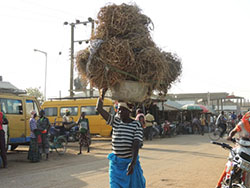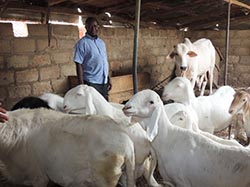Livestock fattening is one of the major occupations of the people of Bawku in the Upper East Region of Ghana. It is a business considered to be for landless people in the society. Bawku is one of the project districts of the N2Africa project. The district is highly populated and farming land is a scarce commodity.
As part of my PhD work, I am assessing the trends in the use and management of grain legume residues (GLRs) among different farm types and other livestock production chain actors in northern Ghana. Based on this, focus group discussions (FGDs) were held with groups of smallholder farmers, livestock traders and fatteners.
Focus group discussion held with Kpolore Livestock Farmers Association (mainly fatteners) in Bawku revealed how important N2Africa Project is to their business. They stated that any innovation and technology improving the productivity of grain legumes is a booster to their enterprises, because they make GLRs available and easily accessible. The core business of these livestock fatteners is to fatten animals, particularly ruminants (cattle, sheep and goats), for special occasions such as Christian and Moslem festivals in Ghana. These livestock fatteners obtain their animals from smallholder farmers at local markets around Bawku in Ghana and from other villages along the borders of Burkina Faso and Togo. They keep their animals for a particular period of time under intensive management system, where the animals are fed indoor. During the keeping period, the animals are fed, watered, dewormed and treated against any ill-health issues to attain a accepted size and weight for the market.
Preliminary results from the study indicated that about 70% of the feed resources for fattening livestock are composed of GLRs (particularly cowpea, groundnut and soyabean residues). Cereal residues from crops, such as maize, rice sorghum and millet, provided about 20% of their feed and the remaining 10% came from other sources. Among the GLRs, cowpea haulms were rated as the most nutritious feed, followed by groundnut and soyabean, being the least rated among the three main grain legumes grown in northern Ghana. The rating was based on the following criteria; acceptance among animals, number of leaves on the stocks, storability and fibrous nature of the stocks.
 |
 |
 |
Figure 1. Grain legume residues being conveyed to the market for sale in Bawku, Ghana
|
Another important finding worth noting is the fact that market has been created for GLRs (Figure 1). This market employs many people, especially women in selling GLRs to earn additional income. We visited the farm of Mr Abdala Awal and he told us he is making a living as a livestock fattener, because he is able to cater for his family, pay his children’s school fees and save for future businesses (Figure 2). However, these fatteners face challenges, such as high cost of veterinary medicines and services, high cost of formulated feeds (concentrates) and shortage of water during the dry season. They also complained about lack of financial services to support their business. |
Figure 2. Mr Abdala Awal with some of his fattened animals ready for the market |
Detailed studies will be conducted to investigate the trends in the use and management of GLRs among livestock production chain actors and also to quantify the return on investment of livestock fatteners as compared to smallholder farmers and livestock traders.
Daniel Brain Akakpo, Wageningen University, The Netherlands (Click here for his 2015 update)

